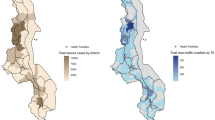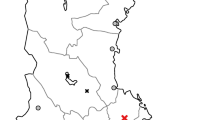Abstract
Background
Advances in trauma care in high-income countries have significantly reduced late deaths following trauma, challenging the classical trimodal pattern of trauma-associated mortality. While studies from low and middle-income countries have demonstrated that the trimodal pattern is still occurring in many regions, there is a lack of data from sub-Saharan Africa evaluating the temporal epidemiology of trauma deaths.
Methods
We conducted a retrospective analysis of the trauma registry at Kamuzu Central Hospital in Lilongwe, Malawi, including all injured patients presenting to the emergency department (ED) from 2009 to 2021. Patients were compared based on timing of death relative to time of injury. We then used a modified Poisson regression model to identify adjusted predictors for early mortality compared to late mortality.
Results
Crude mortality of patients presenting to the ED in the study period was 2.4% (n = 4,096/165,324). Most patients experienced a pre-hospital death (n = 2,330, 56.9%), followed by death in the ED (n = 619, 15.1%). Early death (pre-hospital or ED) was associated with transportation by police (RR1.52, 95% CI 1.38, 1.68) or private vehicle (RR1.20, 95% CI 1.07, 1.31), vehicle-related trauma (RR1.10, 95% CI 1.05, 1.14), and penetrating injury (RR1.11, 95% CI 1.04, 1.19). Ambulance transportation was associated with a 40% decrease in the risk of early death.
Conclusions
At a busy tertiary trauma center in Malawi, most trauma-associated deaths occur within 48 h of injury, with most in the pre-hospital setting. To improve clinical outcomes for trauma patients in this environment, substantial investment in pre-hospital care is required through first-responder training and EMS infrastructure.

Similar content being viewed by others
References
Wesson HK, Boikhutso N, Bachani AM et al (2014) The cost of injury and trauma care in low- and middle-income countries: a review of economic evidence. Health Policy Plan 29:795–808
Chen S, Kuhn M, Prettner K et al (2019) The global macroeconomic burden of road injuries: estimates and projections for 166 countries. Lancet Planet Health 3:e390–e398
Trunkey DD (1983) Trauma. Accidental and intentional injuries account for more years of life lost in the U.S. than cancer and heart disease. Among the prescribed remedies are improved preventive efforts, speedier surgery and further research. Sci Am 249:28–35
Pfeifer R, Tarkin IS, Rocos B et al (2009) Patterns of mortality and causes of death in polytrauma patients–has anything changed? Injury 40:907–911
Demetriades D, Kimbrell B, Salim A et al (2005) Trauma deaths in a mature urban trauma system: is “trimodal” distribution a valid concept? J Am Coll Surg 201:343–348
Abbasi H, Bolandparvaz S, Yadollahi M et al (2017) Time distribution of injury-related in-hospital mortality in a trauma referral center in South of Iran (2010–2015). Medicine (Baltimore) 96:e6871
Samuel JC, Akinkuotu A, Villaveces A et al (2009) Epidemiology of injuries at a tertiary care center in Malawi. World J Surg 33:1836–1841. https://doi.org/10.1007/s00268-009-0113-4
Pang J-M, Civil I, Ng A et al (2008) Is the trimodal pattern of death after trauma a dated concept in the 21st century? Trauma deaths in Auckland 2004. Injury 39:102–106
Gallaher J, Jefferson M, Varela C et al (2019) The Malawi trauma score: a model for predicting trauma-associated mortality in a resource-poor setting. Injury 50:1552–1557
Chen W, Qian L, Shi J et al (2018) Comparing performance between log-binomial and robust Poisson regression models for estimating risk ratios under model misspecification. BMC Med Res Methodol 18:63
Zou G (2004) A modified poisson regression approach to prospective studies with binary data. Am J Epidemiol 159:702–706
Grudziak J, Gallaher J, Banza L et al (2017) The Effect of a surgery residency program and enhanced educational activities on trauma mortality in Sub-Saharan Africa. World J Surg 41:3031–3037. https://doi.org/10.1007/s00268-017-4272-4
Gallaher JR, Yohann A, Purcell LN et al (2021) Trends in head injury associated mortality in Malawi. Injury 52:1170–1175
Banza LN, Gallaher J, Dybvik E et al (2018) The rise in road traffic injuries in Lilongwe, Malawi: a snapshot of the growing epidemic of trauma in low income countries. Int J Surg Open 10:55–60
Schlottmann F, Tyson AF, Cairns BA et al (2017) Road traffic collisions in Malawi: Trends and patterns of mortality on scene. Malawi Med J 29:301–305
Robinson B, Purcell LN, Kajombo C et al (2021) Outcomes of stab wounds presenting to Kamuzu Central Hospital in Malawi. Malawi Med J 33:1–6
Purcell LN, Mulima G, Reiss R et al (2020) Epidemiological comparisons and risk factors for pre-hospital and in-hospital mortality following traumatic injury in Malawi. World J Surg 44:2116–2122. https://doi.org/10.1007/s00268-020-05470-w
Wandling MW, Nathens AB, Shapiro MB et al (2016) Police transport versus ground EMS: a trauma system-level evaluation of prehospital care policies and their effect on clinical outcomes. J Trauma Acute Care Surg 81:931–935
Colnaric JM, Bachir RH, El Sayed MJ (2021) Factors associated with survival in adult trauma patients transported to US trauma centers by police. Prehosp Disaster Med 36:58–66
Bou Saba G, Bachir R, El Sayed M (2022) Impact of trauma center designation level on the survival of trauma patients transported by police in the United States. Prehosp Emerg Care 26:582–589
Mowafi H, Oranmore-Brown R, Hopkins KL et al (2016) Analysis of prehospital transport use for trauma patients in Lusaka, Zambia. World J Surg 40:2868–2874. https://doi.org/10.1007/s00268-016-3629-4
Möller A, Hunter L, Kurland L et al (2018) The association between hospital arrival time, transport method, prehospital time intervals, and in-hospital mortality in trauma patients presenting to Khayelitsha Hospital, Cape Town. Afr J Emerg Med 8:89–94
Purcell LN, Mulima G, Nip E et al (2021) Police transportation following vehicular trauma and risk of mortality in a resource-limited setting. World J Surg 45:662–667.https://doi.org/10.1007/s00268-020-05853-z
Balhara KS, Bustamante ND, Selvam A et al (2019) Bystander assistance for trauma victims in low- and middle-income countries: a systematic review of prevalence and training interventions. Prehosp Emerg Care 23:389–410
Lukumay GG, Ndile ML, Outwater AH et al (2018) Provision of post-crash first aid by traffic police in Dar es Salaam, Tanzania: a cross-sectional survey. BMC Emerg Med 18:45
Jayaraman S, Mabweijano JR, Lipnick MS et al (2009) Current patterns of prehospital trauma care in kampala, uganda and the feasibility of a lay-first-responder training program. World J Surg 33:2512–2521. https://doi.org/10.1007/s00268-009-0180-6
Merchant A, Outhay M, Gonzaléz-Calvo L et al (2015) Training laypersons and hospital personnel in basic resuscitation techniques: an approach to impact the global trauma burden in Mozambique. World J Surg 39:1433–1437. https://doi.org/10.1007/s00268-015-2966-z
Mock CN, Tiska M, Adu-Ampofo M et al (2002) Improvements in prehospital trauma care in an African country with no formal emergency medical services. J Trauma Acute Care Surg 53:90–97
Chokotho L, Mulwafu W, Singini I et al (2017) First responders and prehospital care for road traffic injuries in Malawi. Prehosp Disaster Med 32:14–19
Author information
Authors and Affiliations
Corresponding author
Additional information
Publisher's Note
Springer Nature remains neutral with regard to jurisdictional claims in published maps and institutional affiliations.
Rights and permissions
Springer Nature or its licensor (e.g. a society or other partner) holds exclusive rights to this article under a publishing agreement with the author(s) or other rightsholder(s); author self-archiving of the accepted manuscript version of this article is solely governed by the terms of such publishing agreement and applicable law.
About this article
Cite this article
Gallaher, J., An, S.J., Kayange, L. et al. Tri-modal Distribution of Trauma Deaths in a Resource-Limited Setting: Perception Versus Reality. World J Surg 47, 1650–1656 (2023). https://doi.org/10.1007/s00268-023-06971-0
Accepted:
Published:
Issue Date:
DOI: https://doi.org/10.1007/s00268-023-06971-0




